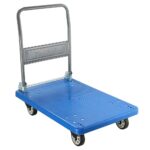In the dynamic realm of contemporary work environments, the role of office furniture has undergone a profound transformation. The once-static, uninspiring cubicles and utilitarian desks have given way to a new era of design, where functionality, comfort, and aesthetics converge to create innovative workspaces. This article explores the evolution of modern office furniture, examining the latest trends that are reshaping the way we work.
The Rise of Open and Collaborative Spaces
One of the most notable shifts in modern office furniture design is the move towards open and collaborative spaces. Traditional closed-off offices and cubicles are being replaced by layouts that foster communication and teamwork. Desks are no longer isolated islands; instead, they are arranged in clusters, encouraging spontaneous interactions and idea-sharing among colleagues.
Modular furniture solutions have gained immense popularity in such environments. These adaptable pieces can be easily rearranged to accommodate different work setups, providing flexibility that aligns with the dynamic nature of modern work. Companies are increasingly recognizing the importance of collaboration in driving innovation, and the office furniture landscape is evolving to support this cultural shift.
Ergonomics Take Center Stage
As awareness of the impact of prolonged office work on health has grown, the focus on ergonomic office furniture has intensified. Ergonomically designed chairs, adjustable desks, and accessories aim to enhance employee well-being by promoting proper posture and reducing the risk of musculoskeletal issues.
Ergonomic chairs, in particular, have become a staple in modern offices. These chairs are designed to provide optimal support to the spine, neck, and limbs, reducing discomfort and fatigue associated with long hours of sitting. Adjustable height desks allow employees to switch between sitting and standing positions, promoting movement throughout the day and mitigating the adverse effects of a sedentary lifestyle.
Investing in ergonomic office furniture not only demonstrates a commitment to employee health and comfort but also contributes to increased productivity. When employees are physically comfortable, they are more likely to stay focused and engaged in their tasks, leading to improved overall performance.
Aesthetics and Functionality in Harmony
Gone are the days when office furniture was solely chosen for its functionality; today’s designs seamlessly blend aesthetics with practicality. Employers recognize that a visually appealing workspace can positively impact employee morale, creativity, and motivation.
Contemporary office furniture incorporates sleek lines, minimalist designs, and a variety of materials to create an atmosphere of sophistication. From the reception area to individual workstations and meeting rooms, furniture choices contribute to the overall ambiance of the workspace. Designers are experimenting with textures, colors, and innovative materials to make office furniture more than just utilitarian – it is now a reflection of the company’s brand and culture.
In addition to aesthetics, multifunctionality is a key consideration in modern office furniture design. Desks with built-in charging stations, storage solutions that double as seating, and modular furniture that can be easily reconfigured for different purposes are becoming increasingly popular. This emphasis on versatility ensures that office spaces remain adaptable to the changing needs of the modern workforce.
The Tech-Integrated Workspace
The integration of technology into office furniture is another defining characteristic of the modern workspace. As digital tools become essential for daily work tasks, office furniture is evolving to accommodate these technological advancements seamlessly.
Smart desks with built-in USB ports, wireless charging capabilities, and integrated cable management systems are becoming standard features in contemporary offices. These innovations eliminate the clutter of cables and provide a streamlined, organized workspace. Collaborative spaces often feature interactive displays, allowing teams to share ideas and information effortlessly.
The incorporation of technology not only enhances functionality but also aligns with the preferences of the tech-savvy younger workforce. Employers aiming to attract and retain top talent recognize the importance of providing a technologically advanced and connected work environment.
Sustainability and Corporate Responsibility
In the wake of growing environmental concerns, sustainability has become a significant consideration in modern office furniture design. Companies are increasingly seeking furniture solutions that align with their commitment to corporate social responsibility and environmental stewardship.
Manufacturers are responding to this demand by using eco-friendly materials, adopting sustainable production practices, and designing furniture that is easily recyclable or biodegradable. Additionally, there is a rising trend in refurbishing and repurposing existing furniture to extend its lifecycle, reducing waste and contributing to a circular economy.
Sustainable office furniture not only appeals to environmentally conscious consumers but also aligns with the values of employees who prioritize working for socially responsible organizations. As the awareness of climate change and resource depletion grows, sustainable office furniture will likely continue to gain prominence in the modern workplace.
Conclusion
The evolution of modern office furniture reflects a broader transformation in the way we approach work. The shift towards open, collaborative spaces, the emphasis on ergonomics, the fusion of aesthetics and functionality, the integration of technology, and the commitment to sustainability all contribute to creating work environments that foster creativity, productivity, and employee well-being.
As companies recognize the impact of the physical workspace on employee satisfaction and performance, the demand for innovative office furniture solutions will continue to drive the evolution of design. The modern office is no longer a static, one-size-fits-all environment; it is a dynamic, adaptable space that evolves with the needs and preferences of the workforce. Whether through cutting-edge ergonomic designs, tech-integrated solutions, or sustainable practices, modern office furniture is an essential component in shaping the future of work.







